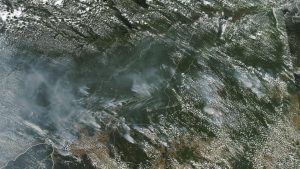The Amazon basin, spanning 7.4 million square kilometers, covers nearly 40 percent of Latin America and is spread across nine countries: Bolivia, Brazil, Colombia, Ecuador, French Guiana, Guyana, Peru, Suriname and Venezuela. About 60 percent of it is in Brazil.
The Amazon forest, of which 2.1 million sq km are protected zones, is home to a biodiversity sanctuary that is unique in the world.
A quarter of the Earth’s species are found there, namely 30,000 types of plants, 2,500 fish, 1,500 birds, 500 mammals, 550 reptiles and 2.5 million insects, according to the Amazon Cooperation Treaty Organization (ACTO).
In the past 20 years, 2,200 new species of plants and vertebrates have been discovered there.
– ‘Lungs of the earth’ –
The Amazon contains a third of the world’s primary forests and, via the Amazon River and its tributaries, provides 20 percent of the Earth’s unfrozen fresh water.
The Amazon is the world’s largest river and — by some accounts since new research was carried out in 2007 — the longest, running for up to 6,900 kilometers (4,287 miles).
The forest acts as a carbon sink, absorbing more CO2 than it emits while releasing oxygen, and stocking 90 to 140 billion tonnes of CO2, which helps regulate worldwide global warming, according to the World Wildlife Fund (WWF).
But deforestation is reducing this capacity for absorbing CO2.
– 420 tribes –
The Amazon has been inhabited for at least 11,000 years and today counts 34 million people, of whom two-thirds live in cities.
Nearly three million are Indians who are members of some 420 different tribes, around 60 of which live in total isolation, according to ACTO. The Amazon’s Indians speak 86 languages and 650 dialects.
The largest Amazon tribe is the Tikuna, counting some 40,000 members who live in Brazil, Peru and Colombia, according to Survival International.
Brazilian Indian chief from the Kayapo tribe, Raoni Metuktire, is the leading campaigner in the campaign against deforestation in the Amazon and has traveled the world for three decades calling for the preservation of the forest and its indigenous population.
Manaus is the capital of Amazonas state, the largest in Brazil and spanning 1.5 million km2.
Founded by the Portuguese in 1669 on the banks of the Rio Negro, near its confluence with the Amazon River, Manaus has a population of 1.8 million.
After fast expansion at the end of the 19th century due to the rubber trade, the city went into major decline until the creation of a free trade zone in 1967.
Manaus now lives mainly off its industrial sector, importing spare parts and exporting end products, notably electronic equipment.
After Sao Paulo and Rio de Janeiro, Manaus is Brazil’s third main economic hub.
– Massive deforestation –
Almost 20 percent of the Amazon forest has disappeared in the last half-century, according to the WWF, and this is accelerating.
Since Brazil’s President Jair Bolsonaro took power in at the start of 2019, the rate of deforestation by July was nearly four times higher than a year earlier, according to a satellite system known as DETER, which is used by the National Institute for Space Research (INPE).
According to the INPE, which tracks clear-cutting of the rainforest, around 2,254 km2 of the Amazon forest were cleared in July, a spike of 278 percent from a year ago.
The main causes of deforestation are soya and livestock farming, the construction of hydroelectric dams and roads, the mining industry and forest fires.
As well as its rich biodiversity, the Amazon is rich in minerals resources including gold, copper, tantalum, iron ore, nickel and manganese.
Sections of the forest are now being devoured by fires.
INPE figures show nearly 73,000 forest fires were recorded in Brazil between January and August — the highest number for any year since 2013. Most of them were in the Amazon.That compares with 39,759 in all of 2018.


